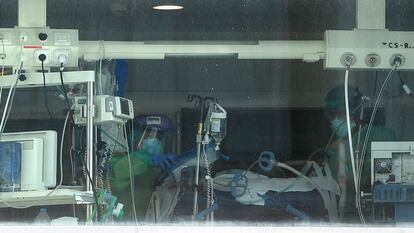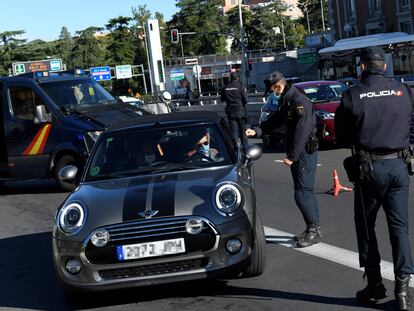Spain’s coronavirus incidence on ‘red alert’ since August, documents show
Authorities have not released information about the thresholds they are working with, but papers seen by EL PAÍS prove that as early as July they set a top figure of 60 positive cases per 100,000 people

From the beginning of the coronavirus crisis, the Spanish Health Ministry has been avoiding publishing epidemiological thresholds on which to base policy decisions.
The only time that Spanish central health authorities did establish a clear number – a 14-day incidence rate of 500 positive cases per 100,000 inhabitants, together with other parameters – it was to slow down “extreme situations” such as the one currently being experienced by the Madrid region.
But despite the lack of public disclosure regarding epidemiological milestones to watch out for, both central and regional authorities have privately been working with specific figures since the month of July. And in terms of the incidence rate, the whole of Spain long ago passed the number deemed a cause for maximum alert: 60 cases per 100,000 people over a 14-day period, according to an internal scale seen by EL PAÍS. By comparison, some parts of Madrid currently have an incidence rate of over 1,000 cases.
The Health Ministry has also been using a three-tier “traffic-light” alert level system since July 13, but these alert levels do not come with a list of measures to be taken in each scenario. Instead, they are simply meant to provide a picture of the situation in each region compared to Spain as a whole, said a spokesperson.
Three-tier system
In its working documents, the Health Ministry has been using a three-tier “traffic-light” alert level system since July 13, when it published its Early response plan in a scenario of control of the Covid-19 pandemic. The ministry uses 13 indicators to assess the situation in every province of Spain, and conducts an analysis of these figures with regional authorities on a weekly basis. There are three colors – green, amber and red – depending on the situation, but these alert levels do not come with a list of measures to be taken in each scenario.
While the 13 indicators themselves are public knowledge, the thresholds associated with each one have been kept under wraps. According to documents seen by EL PAÍS, back in July the Health Ministry believed that a seven-day incidence rate of under 10 cases per 100,000 inhabitants represented a good situation; between 10 and 20 an intermediate situation, and anything over 30 (which is the same as 60 cases per 100,000 over a period of 14 days) was bad.

In Spain, the second wave of the coronavirus burnt through the stages, and there was no slow transition from one alert level to the next: no single region spent more than two straight weeks in the amber scenario. By August 17, every region of Spain – save for Asturias, Extremadura and the exclave city of Ceuta in North Africa – had moved past the highest threshold.
While the various regional governments responded in different ways, not one of them took serious action even when the incidence rate shot up to the red alert level. In general, all of them waited until the rate was well in excess of 60 cases per 100,000 before doing something about it.
On August 14, when Spain’s epidemiological scenario was starting to look increasingly red, the ministry called a meeting with regional authorities to agree on a shared set of restrictions, such as closing down nighttime venues and banning smoking unless a two-meter distance was maintained.
13 indicators
The incidence rate is one of 13 indicators meant to be evaluated as a whole to determine the situation of any region. Others include reporting delays, an increase in symptomatic cases, the percentage of known transmission chains, the rate of PCR tests conducted at primary care centers, and the number of contacts traced back to every positive case.
Even though the ministry’s internal reports use specific thresholds to determine the situation of any given area, a ministry spokesperson said that the figures are not meant as decision-making triggers. Instead, they should be merely viewed as a way to analyze the situation of each region within Spain as a whole.
“These are dynamic thresholds to develop situation maps, so they are constantly changing. Right now, Spain has a 14-day incidence in excess of 60 cases per 100,000 inhabitants, so it needs to be updated,” said the spokesperson.

Many experts have criticized the lack of clear indicators to make policy decisions. Epidemiologists defend that not one but several indicators must be used, and that some of them must be made public. Ildefonso Hernández, a spokesperson for the Spanish Society for Public Health (Sespas), thinks that a threshold of 60 cases per 100,000 should be established after which there should be cause for concern.
“This debate between 1,000 or 500 cases [per 100,000] seems useless to me,” he said, alluding to the recent feud between the central and Madrid governments over the incidence rate that should trigger restrictive measures. “I’m already worried at 50 cases. There are some levels that allow you to negotiate with the virus or to quietly live with it because you know you can control any given event and go back to normal. But when you reach upwards of 100 cases per 100,000 inhabitants, you have to make very significant efforts, considering the number of asymptomatic cases and superspreaders.”
Last week, the government published orders to introduce perimetral confinements and limits on hospitality and other businesses in municipalities with a 14-day incidence rate of 500 cases per 100,000. The Health Ministry is now working on a new traffic-light system that will be public, and which will urge regions to take specific measures when they reach certain thresholds.
Delayed decisions
The recent battle between central and Madrid authorities over how to curb transmission in the region, and who should be in charge of it, illustrates the decision-making difficulties seen in Spain since the beginning of the crisis.
In Spain, healthcare policy is devolved to the regions, but in mid-March the central executive invoked emergency powers to impose a 99-day national lockdown to slow the spread of the virus. The central government was accused by some regional authorities, including Madrid, of not letting them deal with the crisis in a more efficient manner. Restrictions were gradually loosened and the country emerged from confinement in mid-June, when healthcare powers were fully restored to the regions. But coronavirus cases have been escalating since then, and Spain is once again one of the world’s hardest-hit countries.
Figures released on Thursday show that the Madrid region continues to be the epicenter of the health crisis in Spain, accounting for nearly 35% of the new cases reported by the ministry, despite accounting for just 14% of the country’s population. Health Minister Salvador Illa recently described the situation there as one of “community transmission.”
English version by Susana Urra.
Tu suscripción se está usando en otro dispositivo
¿Quieres añadir otro usuario a tu suscripción?
Si continúas leyendo en este dispositivo, no se podrá leer en el otro.
FlechaTu suscripción se está usando en otro dispositivo y solo puedes acceder a EL PAÍS desde un dispositivo a la vez.
Si quieres compartir tu cuenta, cambia tu suscripción a la modalidad Premium, así podrás añadir otro usuario. Cada uno accederá con su propia cuenta de email, lo que os permitirá personalizar vuestra experiencia en EL PAÍS.
¿Tienes una suscripción de empresa? Accede aquí para contratar más cuentas.
En el caso de no saber quién está usando tu cuenta, te recomendamos cambiar tu contraseña aquí.
Si decides continuar compartiendo tu cuenta, este mensaje se mostrará en tu dispositivo y en el de la otra persona que está usando tu cuenta de forma indefinida, afectando a tu experiencia de lectura. Puedes consultar aquí los términos y condiciones de la suscripción digital.
More information
Últimas noticias
The complicated life of Francesca Albanese: A rising figure in Italy but barred from every bank by Trump’s sanctions
How Japan is trying to avert ‘digital defeat’
Reinhard Genzel, Nobel laureate in physics: ‘One-minute videos will never give you the truth’
Pinochet’s victims grapple with José Antonio Kast’s rise in Chile
Most viewed
- Pablo Escobar’s hippos: A serious environmental problem, 40 years on
- Why we lost the habit of sleeping in two segments and how that changed our sense of time
- Trump’s obsession with putting his name on everything is unprecedented in the United States
- The Florida Keys tourist paradise is besieged by immigration agents: ‘We’ve never seen anything like this’
- Charles Dubouloz, mountaineering star, retires at 36 with a farewell tour inspired by Walter Bonatti










































